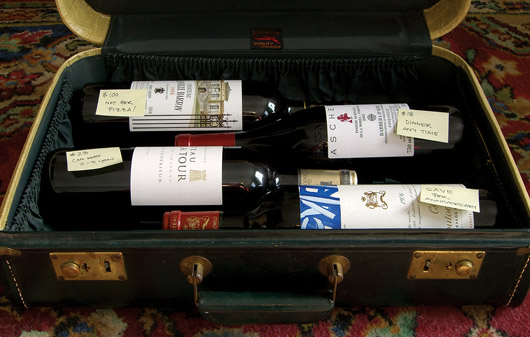No sight chills me more completely than a collection of good bottles of wine lying in a stylish wine rack on a friend’s counter. Perhaps next to the toaster. Or bathed in the warm glow of a sunbeam. Try as I might to suppress my inner wine snob, I find myself palpitating. But besides being a snob, I am also a coward, so I rarely voice my objections. Interventions can be so messy. Better just to write a column.

No matter how attractive your wine rack is, do not store wine in your kitchen unless you plan to drink it within a week or two. Light, heat, and frequent alterations in temperature pummel the finer flavours in wine.
Not that wine should only be kept in a hermetically sealed vault. Starting a wine cellar is easy, and an actual cellar isn’t required. For short cellaring (two to three years), any dark place with a fairly steady temperature is fine: in a drawer, at the back of a closet, or under your bed (although vibrations are also bad for wine — ahem). Lay the bottles on their sides to prevent the cork from drying out, and wait for time to work its magic.
If you are cellaring wine for longer than a couple of years, you’ll want to find a place that’s closer to 12 to 14 C. A wine fridge, a coldroom, a subterranean condo locker, or even a place under the stairs may be your best bet — just use a thermometer to ensure that the mercury doesn’t swing more than a couple degrees between day and night. Gradual changes in temperature from season to season aren’t a problem.
The most important tool for beginning your cellar is a package of Post-it Notes from the firm’s supply room. Stick one to each bottle to remind yourself when you got the wine, what inspired you to get it, and when you want to drink it. You’d be surprised at how much you can forget after a few months. I once accidentally drank a $45 bottle with pizza and only clued in the next day after noticing that my hangover was particularly refined.
When I moved into my house, I designated a side room in the basement as the wine cellar. At first it seemed ideal, but nothing is perfect when you look with an obsessive eye. It struck me as warm, so I stripped the floor to let the coolness of unfinished concrete permeate the room. Then I used a crowbar to expose the foundation. Finally, I punched a hole in a wall to install a special cooling unit (like an air conditioner).
The cellar is wonderful now, but I reduced half of my finished basement to a cavern. My girlfriend sat me down. “You have a problem.” Interventions can be so messy.
DIY wine cellar
Cooler temperatures keep wine from aging too fast. Here are some solutions for keeping your wine cool.
Novice
Wine fridges come in all sizes. I like the 12 bottle Avanti EWC120B ($145). Beware: they fill up fast once you start collecting!
Going pro
Is your coldroom too hot? Mine was, so I ordered a Breezaire cooling unit from The Wine Establishment (1-800-268-8418) and installed it in my basement.
Overachiever
Farm out your wine cellaring to a professional wine storage facility, like the Fine Wine Reserve (finewinereserve.com)
in Toronto or A1 Mini in Ottawa (a1mini.com). Or find a friend with a cellar and commandeer some space. I’m cellaring more than a hundred bottles for friends.
Two great wines to put away
 Flat Rock
Flat Rock
2006 Pinot Noir
($19.95 [Ed. note: 2006 no longer available], Vintages Essentials,# 001545)
is the most satisfying Pinot for under $20.00 that I have tasted in years. It’s not a big, extroverted wine — rather, it’s got a shockingly light colour with a fine-grained texture and subtle flavours to match: cranberry, sour cherry, tree bark, and a dash of cinnamon on the nose. A couple more years will only enhance its lithe elegance.
 Cathedral Cellar
Cathedral Cellar
2004 Cabernet Sauvignon
($16.85 [Ed. note: 2004 no longer available], Vintages #328567) is a lantern-jawed hunk of a wine. It’s so dense with flavour that its colour is nearly opaque. It’s aggressive, with milk chocolate, leather, and eucalyptus, and some fine acidity. Right now it’ll take all comers (steak, BBQ, chili) but about two years in the cellar will coax the underlying fruit out, giving it a complexity that it lacks now.
Matthew Sullivan is a lawyer with the Department of Justice. He can be reached at matthew@lawandstyle.beta-site.ca. Follow Matthew’s adventures in cellaring every Tuesday at www.lawandstyle.ca/shortcellar.
Photography by Catherine Dean

